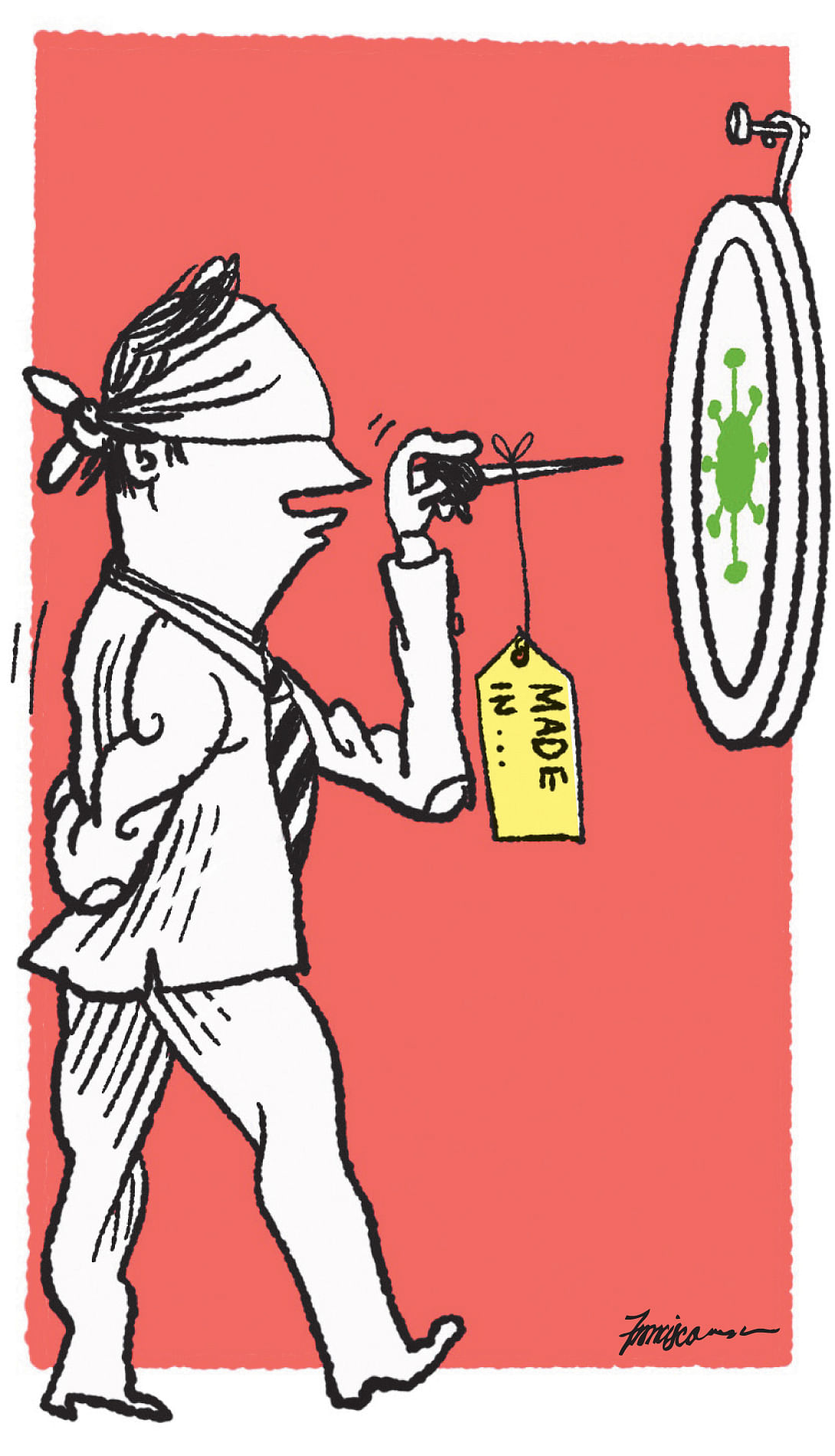The Covid-19 pandemic has already killed more than 160,000 people worldwide, and is about to reshape the global economy. It has also given rise to a whole industry of conspiracy theories.
United Nations Secretary-General Antonio Guterres is so worried by what he calls this "dangerous epidemic of misinformation" that he has announced the creation of a special task force of his officials to "flood the Internet with facts and science".
Sadly, however, while the race to produce a vaccine against the coronavirus is moving fast, the search for a vaccine against the acceptance and spread of conspiracy theories is bound to take longer.
Historically, every life-threatening epidemic produced its own conspiracy theories and, of course, also its scapegoats. For example, the Black Death, which may have killed around 30 per cent of the world's population in the 14th century, was widely blamed on the Jews and spawned many of the anti-Semitic tropes that continue to this day.
So, it is not surprising that the current pandemic conspiracy theories also function as a self-soothing mechanism, as an attempt to make what doesn't seem to make sense sensible. And they have also become weapons, used by governments and individuals.
BATS AND BIOWEAPONS
Probably one of the most potent conspiracy theories in circulation is the allegation that the current pandemic was started by a virus that escaped from some Chinese laboratory in Wuhan.
As befits any conspiracy theory, this one starts by putting together some undisputed facts. It is true that there are two Chinese labs in Wuhan, the epicentre of the outbreak. It is also true that one of these labs holds the highest international safety security classification, which means that it is dealing with some pretty dangerous pathogens.
Finally, it is a fact that the first allegation of a potential leak from a Wuhan laboratory surfaced in an article written by two Chinese scientists, giving the theory an air of added credibility.
On closer inspection, however, little about the story makes any sense. The Chinese scientists wrote about the possible pathways between infected horseshoe bats (which have been identified as the possible origins of the disease) and the wet market in Wuhan, where the virus outbreak reportedly began.
The authors concluded that two pathways that may have led to the presence of contagion-bearing bats in the market were improbable because bats were neither sold nor eaten in that particular market, and the horseshoe bats cannot reach the area by flying.
They noted that a third possible pathway could lie in the two labs working on coronaviruses near the Huanan wet market.

But the fact that bats were not physically present in Wuhan's wet market - either as pests or as potential food - is not as mysterious or significant as it is meant to sound. For most scientists accept that bats probably did not infect humans directly, but may have infected another animal which then acted as an intermediary, providing the transmission mechanism to humans.
The questionable premise about bats in the study did not deter conspiracy theorists - what caught their attention was the presence of the two labs in Wuhan and they became central to the idea that the virus was a product of China's biological warfare research.
Yet, this claim is flimsy for one fundamental reason: The coronavirus is neither deadly enough, nor easily transmissible enough for military purposes. Simply put, if China wanted to possess a bioweapon, there are much deadlier pathogens such as the Crimean-Congo haemorrhagic fever, which has a death rate of 50 per cent.
Yet, this conspiracy theory continues to be eagerly picked up by some politicians in the United States, including President Donald Trump. All are attracted to the fact that the tale not only supposedly fingers China as the culprit, but also appears to connect the Chinese military to this health disaster.
So, presumably, those American politicians who continue to peddle this unsubstantiated claim won't mind very much if they are also on the receiving end of another big conspiracy theory making the rounds: That the virus actually originated in the US.
Yet again, this theory is based on some disparate facts, randomly thrown together. The story involves Fort Detrick in Maryland, America's biological research centre, which was forced to close down last year because, supposedly, it failed to follow safety procedures in handling pathogens.
The story then proceeds to claim that some American soldiers who attended the World Military Games in Wuhan last October fell ill - yet again, true.
Into the mix is a short video clip last month of Dr Robert Redfield, the head of the Centres for Disease Control and Prevention (CDC), stating that some of the deaths recorded in the US as the result of flu were actually Covid-19 cases.
To add plausibility to the claim that American soldiers brought Covid-19 to China, a hitherto obscure scientist named Dr Helen Chu, who runs the Seattle Flu Study, is said to have been blocked from unravelling this mystery.
However, a closer examination of the elements shows problems with this theory.
First, as a matter of background, Fort Detrick has featured in all anti-US conspiracy theories dating back to the 1980s, when the Soviet Union blamed the Americans for "manufacturing" the HIV virus which causes Aids as part of its disinformation campaign.
Fort Detrick was indeed temporarily shut last August, not because it failed to handle viruses correctly, but because it didn't have "sufficient systems in place to decontaminate wastewater".
There was, however, "no threat to public health… and no leaks of dangerous material", according to US regulators at that time.
Furthermore, how can one square the theory with the admission by Chinese hospital authorities no less that the US soldiers hospitalised during the Wuhan Games suffered from malaria?
Even assuming that asymptomatic American soldiers somehow got into Wuhan undetected for the October games, how is it possible that, if the coronavirus epidemic originated in the US, it was in China that it spread massively?
One response has been that the US hid the fact that its people were dying of Covid-19, and it is people like Dr Chu who want to get to the bottom of this story but are being prevented from acquiring the evidence from flu swabs collected by the CDC from American patients last year.
Dr Chu is considered a hero by some for being among the first to identify coronavirus infections in Seattle in February this year. But she has done so by - according to her own admission in a New York Times report - ignoring government procedures in operation at the time. So it is not exactly surprising that her demand to obtain samples of flu swabs from last year would be turned down, not because there is anything to hide, but because re-examining medical samples collected by others would have run into problems involving the consent of test subjects and protocols differentiating research labs from clinical ones.
There is no suggestion that Dr Chu herself is peddling conspiracies. But she is now part of the story because her status as a scientist helps strengthen claims of a cover-up.
Mr Zhao Lijian, an official spokesman for China's Ministry of Foreign Affairs, gave a boost to this particular strain of conspiracy theory circulating in Chinese social media when he tweeted last month that "it might be US army who brought the epidemic to Wuhan". It is noteworthy that Mr Cui Tiankai, the Chinese Ambassador in Washington, has dismissed the story that the coronavirus originated in a military laboratory in the US as "crazy".
In short, this Sino-US blame game over the virus is a classic case of that old English adage that what's sauce for the goose is sauce for the gander.
The belief that the virus is part of a nefarious Western plot against its enemies extends beyond the escalating US-China row.
Iran's supreme leader Ayatollah Ali Khamenei, for instance, rejected help from the US and Doctors Without Borders to fight the coronavirus on the grounds that the microbe was "specifically built for Iran using the genetic data of Iranians".
"You might send people as doctors and therapists, maybe they would want to come here and see the effect of the poison they have produced in person," he said last month. A day after his remarks, the Iranian government revoked permission for Doctors Without Borders to set up a field hospital in Isfahan to treat Covid-19 patients.
THE 5G CONNECTION
Yet, there is also a conspiracy theory free of politics: The zany story that 5G - the newest generation of mobile telecommunications infrastructure - is the true cause of the coronavirus pandemic. As a result, no fewer than 60 mobile masts have been set on fire or otherwise damaged in Britain, the Netherlands and Cyprus, to name but a few countries.
The origins of this story can be traced back even further, to panics about earlier generations of mobile phone and wireless technology at the turn of the millennium. In its present form, fears about 5G have been stoked by videos purportedly showing people keeling over in public and dead fish and fowl - all supposed victims of its electromagnetic waves.
The head of Vodafone UK was prompted to warn that lives were being put at risk by a dangerous lie around 5G, after a mast near a coronavirus hospital was vandalised.
Medical conspiracy theories are a tenacious and hydra-headed beast, in addition to being a public health menace. The anti-vaxxer movement and campaign against fluoridation of water are other iterations of this phenomenon.
Why are such theories so appealing?
Professor Patrick Leman of King's College London, one of Britain's top psychiatrists who has researched the topic, claims that there is some underlying process in human psychology that assumes that the more spectacular a news story is, the bigger the "cause" behind it must be.
Can we really believe that a president of the US was killed by a simple, lone gunman hiding in a library loft in Dallas, Texas? Or that glamorous Princess Diana could perish in a stupid car accident on the streets of Paris, simply because she was driven around by a drunken driver? A plot is always more appealing than humdrum reality.
BURDEN OF PROOF
Conspiracy theories invariably thrive on the belief that a handful of unexplained anomalies can undermine a well-established theory. So, no bats in a wet market but a laboratory nearby? That's the answer. A few US soldiers falling ill in Wuhan and a biological lab closing in the US? Clearly something fishy.
All conspiracy theories also gloss over self-evident inconsistencies, usually by shifting the burden of proof away from those who make the accusation. So, instead of having to explain why Dr Chu should be examining old medical samples, the conspiracy theory demands instead why she should not be given access. And instead of explaining why they believe that 5G masts are dangerous to health, conspiracy theory advocates want governments to prove that they are safe.
Of course, proving a negative is an impossibility, and that is the moment when the peddlers of conspiracies claim to have triumphed.
Yet, to recall the old law of propaganda that any lie repeated often enough becomes the truth, there is evidence that conspiracy theories change political narratives.
A new survey by the Pew Research Centre of the US has found that nearly a third of Americans believe the coronavirus was "most likely" produced in a laboratory, and of these, 23 per cent believe the virus was developed intentionally in a lab.
Perhaps French Emperor Napoleon was right all along when he advised his associates to "never attribute to malice what can also be simply explained by stupidity".











